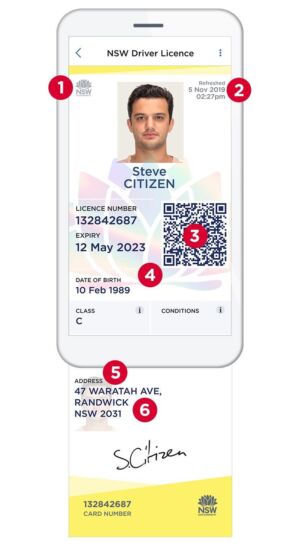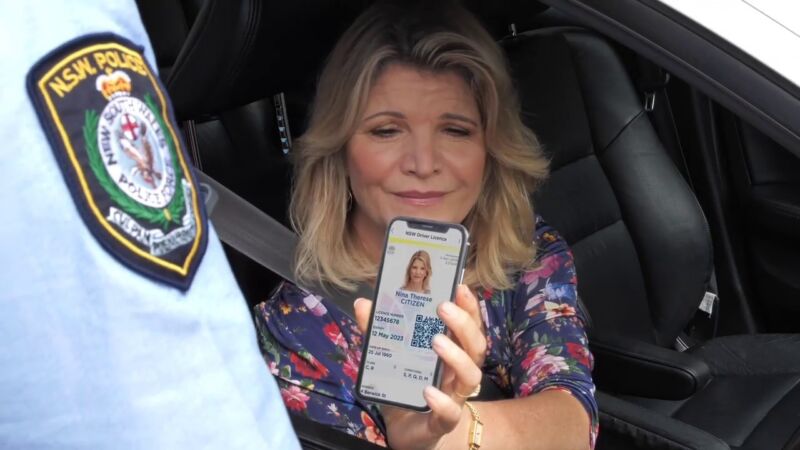In late 2019, the government of New South Wales in Australia rolled out digital driver's licenses. The new licenses allowed people to use their iPhone or Android device to show proof of identity and age during roadside police checks or at bars, stores, hotels, and other venues. ServiceNSW, as the government body is usually referred to, promised it would “provide additional levels of security and protection against identity fraud, compared to the plastic [driver's license]” citizens had used for decades.
Now, 30 months later, security researchers have shown that it’s trivial for just about anyone to forge fake identities using the digital driver's licenses, or DDLs. The technique allows people under drinking age to change their date of birth and for fraudsters to forge fake identities. The process takes well under an hour, doesn’t require any special hardware or expensive software, and will generate fake IDs that pass inspection using the electronic verification system used by police and participating venues. All of this, despite assurances that security was a key priority for the newly created DDL system.
“To be clear, we do believe that if the Digital Driver's Licence was improved by implementing a more secure design, then the above statement made on behalf of ServiceNSW would indeed be true, and we would agree that the Digital Driver's Licence would provide additional levels of security against fraud compared to the plastic driver's licence,” Noah Farmer, the researcher who identified the flaws, wrote in a post published last week.
A better mousetrap hacked with minimal effort
“When an unsuspecting victim scans the fraudster’s QR code, everything will check out, and the victim won't know that the fraudster has combined their own identification photo with someone’s stolen Driver's Licence details,” he continued. As things have stood for the past 30 months, however, DDLs make it “possible for malicious users to generate [a] fraudulent Digital Driver's Licence with minimal effort on both jailbroken and non-jailbroken devices without the need to modify or repackage the mobile application itself.”
DDLs require an iOS or Android app that displays each person’s credentials. The same app allows police and venues to verify that the credentials are authentic. Features designed to confirm the ID is authentic and current include:

- Animated NSW Government logo.
- Display of the last refreshed date and time.
- A QR code expires and reloads.
- A hologram that moves when the phone is tilted.
- A watermark that matches the license photo.
- Address details that don’t require scrolling.
Surprisingly simple
The technique for overcoming these safeguards is surprisingly simple. The key is the ability to brute-force the PIN that encrypts the data. Since it’s only four digits long, there are only 10,000 possible combinations. Using publicly available scripts and a commodity computer, someone can learn the correct combination in a matter of a few minutes, as this video, showing the process on an iPhone, demonstrates.
ServiceNSW Digital Driver's Licence proof-of-concept: Brute-forcing PIN.
Once a fraudster gets access to someone’s encrypted DDL license data—either with permission, by stealing a copy stored in an iPhone backup, or through remote compromise—the brute force gives them the ability to read and modify any of the data stored on the file.
From there, it's a matter of using simple brute-force software and standard smartphone and computer functions to extract the file storing the credential, decrypting it, changing the text, re-encrypting it, and copying it back to the device. The precise steps on an iPhone are:
- Use iTunes backup to copy the contents of the iPhone storing the credential the fraudster wants to modify
- Extract the encrypted file from the backup stored on the computer
- Use brute-force software to decrypt the file
- Open the file in a text editor and modify the birth date, address, or other data they want to fake
- Re-encrypt the file
- Copy the re-encrypted file to the backup folder and
- Restore the backup to the iPhone
With that, the ServiceNSW app will display the fake ID and present it as genuine.
The following video shows the entire process from start to finish.
Death by 1,000 flaws
A variety of design flaws make this simple hack possible.
The first is a lack of adequate encryption. A key based on a four-digit PIN is woefully inadequate. Apple provides a function named SecRandomCopyBytes for producing random bytes that can be used to generate secure keys. “If this was used to encrypt the Digital Driver's Licence rather than the 4 digit PIN, it would make the task of brute-forcing much harder if not completely infeasible for attackers,” Farmer wrote.
The next major flaw is that, astonishingly, DDL data is never validated against the back-end database to make sure that what’s stored on the iPhone matches records maintained by the government department. With no means to natively validate the data, there’s no way to tell when information has been tampered with. As a result, attackers are able to display the falsified data on the Service NSW application without any means to prevent or detect the fraud.
The third shortcoming is that using the “pull-to-refresh” function—a cornerstone of the DDL verification scheme intended to ensure the most current information is showing—fails to refresh any of the data stored in the electronic credential. Instead, it updates only the QR code. A better response would be for the pull-to-refresh function to download the latest copy of the DDL from the ServiceNSW database.
Fourth, the QR code transmits only the DDL holder’s name and status as either over or under the age of 18. The QR code is supposed to allow the person checking the ID to scan it with their own ServiceNSW app to validate that the data presented is authentic. To bypass the check, a fraudster only needs to obtain the driver's license details from a stolen or otherwise-obtained DDL and replace it locally on their phone.
“When an unsuspecting victim scans the fraudster’s QR code, everything will check out, and the victim won't know that the fraudster has combined their own identification photo with someone's stolen Driver's Licence details,” Farmer explained. Had the system returned the legitimate image data, the scanning party would easily see that the fraudster had forged the DDL, since the face returned by Service NSW wouldn’t match the face displayed on the app.
The last flaw the researcher identified was that the app allows the data it stores to be backed up and restored at all. While all files stored in the Documents and Library/Application Support/ folders are backed up by default, iOS allows developers to easily exclude certain files from backup by calling NSURL setResourceValue:forKey:error: with the NSURLIsExcludedFromBackupKey key.
With a reported 4 million NSW residents using the DDLs, the gaffe could have serious consequences for anyone who relies on DDLs to verify identities, ages, addresses, or other personal information. It's not clear how or even if Service NSW plans to respond. Given time differences between San Francisco and New South Wales, officials with the department weren't immediately available for comment.
Farmer noted this tweet, which called out a hotel bar for refusing service to someone who had only physical ID and instead accepting only DDLs. “I know 10 kids that you let in regularly with fake digital licenses because they are easy to make,” the person claimed.
While the veracity of that claim can’t be verified, it certainly sounds plausible, given the ease and effectiveness of the hack shown here.



3175x175(CURRENT).thumb.jpg.b05acc060982b36f5891ba728e6d953c.jpg)

Recommended Comments
There are no comments to display.
Join the conversation
You can post now and register later. If you have an account, sign in now to post with your account.
Note: Your post will require moderator approval before it will be visible.